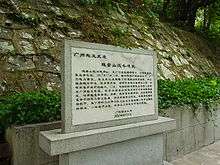Guangzhou Uprising
| Guangzhou Uprising | |||||||
|---|---|---|---|---|---|---|---|
| Part of Chinese Civil War | |||||||
 | |||||||
| |||||||
| Belligerents | |||||||
|
| ||||||
| Commanders and leaders | |||||||
|
|
| ||||||
| Units involved | |||||||
| Red Guard[3] | National Revolutionary Army (NRA) | ||||||
| Strength | |||||||
| 20,000 armed workers and soldiers[2] | 15,000; later reinforced by 5 divisions[2] | ||||||
| Casualties and losses | |||||||
| 5,700[2][4] | heavy[2] | ||||||
| Guangzhou Uprising | |||||||||||
| Traditional Chinese | 廣州起義 | ||||||||||
|---|---|---|---|---|---|---|---|---|---|---|---|
| Simplified Chinese | 广州起义 | ||||||||||
| Cantonese Yale | Gwóngjàu Héiyih | ||||||||||
| |||||||||||
The Guangzhou Uprising, Canton Uprising[2] or Canton Riots of 1927 was a failed Communist uprising in the city of Guangzhou in southern China.
Background
The Communist Party of China (CPC)'s Guangdong Provincial Committee had begun to prepare a uprising in Guangzhou since September 1927. It originally planned to use a large group of Communist-leaning soldiers who had taken part in the failed Nanchang uprising, and were heading into Guangdong for this insurrection. According to these plans, local workers and peasants were only supposed to act as auxiliaries while the soldiers would bear the brunt of the fighting. The troops from Nanchang were defeated at Shantou in early October, however, precluding any attempt to use them for the Guangzhou Uprising.[5] Party head Qu Qiubai consequently decided that the Communists had to convince soldiers who were stationed in Guangdong. A final plan for the rebellion was worked out by the central party leadership and Guangdong secretary Zhang Tailei in Shanghai during November. At the time, the CPC believed that fighting between the Nationalist-aligned warlords Zhang Fakui and Li Jishen was imminent in Guangdong, which would provide them with an opportunity to expolit the chaos by launching multiple simultaneous rebellions and size power in the province.[6]
History
On 11 December 1927, the politicial leadership of the CPC ordered about 20,000 Communist-leaning soldiers and armed workers to organize a "Red Guard"[3] and take over Guangzhou (then romanized as "Canton").[2] The uprising occurred despite the strong objections of Communist military commanders such as Ye Ting, Ye Jianying and Xu Xiangqian, as the Communists were badly armed - just 2,000 of the insurgents had rifles.[3] Neverthless, rebel forces captured most of the city within hours using the element of surprise, despite a huge numerical and technical advantage held by government troops. The Communist leaders officially renamed the city's political structure the "Soviet of Workers, Soldiers and Peasant Deputies"[2] or "Guangzhou Soviet". After this initial success for the Communists, however, the 15,000 National Revolutionary Army (NRA) troops in the area moved into the city and started to push back the insurgents. After five more NRA divisions arrived in Guangzhou, the uprising was quickly crushed. The insurgents suffered heavy casualties, while the survivors had to flee the city or go into hiding.[2] Zhang Tailei, the leading Red Guard organizer, was killed in an ambush as he returned from a meeting. The takeover dissolved by the early morning of December 13, 1927.
In the resulting purges, many young Communists were executed and the Guangzhou Soviet became known as the "Canton Commune",[3] "Guangzhou Commune" or "Paris Commune of the East"; it lasted only a short time at the cost of more than 5,700 Communists dead and an equal number missing. Around 8 p.m. on 13 December, the Soviet consulate in Guangzhou was surrounded and all its personnel were arrested. In the accident the consulate diplomats Ukolov, Ivanov and others were killed.[4] Ye Ting, the military commander, was scapegoated, purged and blamed for the failure, despite the fact that the obvious disadvantages of the Communist force was the main cause of the defeat, as Ye Ting and other military commanders had correctly pointed out. Enraged by his unjustified treatment, Ye Ting left China and went into exile in Europe, not returning until nearly a decade later.
Despite being the third failed uprising of 1927, and reducing the morale of the Communists,[3] it encouraged further uprisings across China.
See also
References
- ↑ Hsiao 1967, p. 65.
- 1 2 3 4 5 6 7 8 9 Jowett 2014, p. 27.
- 1 2 3 4 5 Jowett 2013, p. 167.
- 1 2 "广州起义失败后苏联外交官为何惨遭处决并暴尸示众?_手机凤凰网". ihistory.ifeng.com. Retrieved 2018-08-27.
- ↑ Hsiao 1967, pp. 65–66.
- ↑ Hsiao 1967, p. 66.
Bibliography
- Dirlik, Arif (1 October 1997), "Narrativizing Revolution: The Guangzhou Uprising (11-13 December 1927) in Workers' Perspective", Modern China
- Hsiao, Tso-Liang (April–June 1967). "Chinese Communism and the Canton Soviet of 1927". The China Quarterly (30): 49–78. JSTOR 651862.
- Jowett, Philip S. (2013). China's Wars. Rousing the Dragon 1894–1949. Atglen, Pennsylvania: Schiffer Publishing. ISBN 978-1782004073.
- Jowett, Philip S. (2014). The Armies of Warlord China 1911–1928. Atglen, Pennsylvania: Schiffer Publishing. ISBN 978-0764343452.